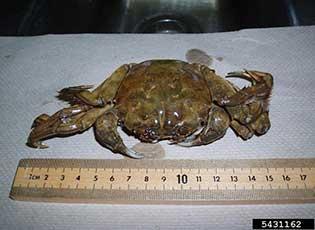Eriocheir sinensis (ITIS)
Chinese mitten crab
Pacific coast of China and Korea (NAS Database)
1991 (West Coast); 2005 (East Coast) (NAS Database)
Ballast water (also possibly through intentional releases) (Cohen and Carlton 1997)
Interference with fish salvage operations, fish passage facilities, water treatment plants, power plants, and other facilities (Cohen and Weinstein 2001)
West Coast; Great Lakes; Chesapeake Bay

Chinese mitten crab, adult
Photo by Ontario Ministry of Natural Resources
Find more images
Spotlights
Distribution / Maps / Survey Status
Federally Regulated
All Resources
Selected Resources
The section below contains highly relevant resources for this species, organized by source.
Council or Task Force
Partnership
Federal Government
International Government
State and Local Government
Academic
Professional
Cohen, A.N. and J.T. Carlton. 1997. Transoceanic transport mechanisms: introduction of the Chinese mitten crab, Eriocheir sinensis, to California. Pacific Science 51(1):1-11.
Cohen, A.N. and A. Weinstein. 2001. The Potential Distribution of Chinese Mitten Crabs (Eriocheir sinensis) in Selected Waters of the Western United States with U.S. Bureau of Reclamation Facilities [PDF, 636 KB]. (Tracy Fish Collection Facilities Studies, Vol. 21). U.S. Bureau of Reclamation.
Integrated Taxonomic Information System. Eriocheir sinensis. [Accessed Aug 20, 2023].
Nonindigenous Aquatic Species Database. Fact Sheet - Chinese Mitten Crab. USGS, Gainesville, FL. [Accessed Aug 20, 2023].
